I. LOVE. ROCKS. Ask anyone close to me. My rocks are taking over the house. I have boxes of rocks, displays of rocks, rocks in my landscaping, and every specimen is special, whether it is in color, shape, or where it came from. Every rock has a story – if – you know how to read it!

Geoscience students: This geology unit covers Semester 2, Class 13. Please complete, “Minerals are Everywhere!” prior to this unit.
Every Rock has a Story
To understand a rock’s story, what type of rock it is, and the adventure it has undergone, you have to know the origins and the minerals within. The rocks in the photo below are stone tools that ancient peoples used in their daily lives. I have discovered that many time we walk on artifacts and we don’t even realize it! My new motto: Leave no stone un-turned.

Three Types of Rocks
There are three types of rocks that makes up the earth’s crust: igneous, sedimentary, and metamorphic rocks. We will discuss each category, as well as the types of rocks most commonly found. You might even get a story – or two!
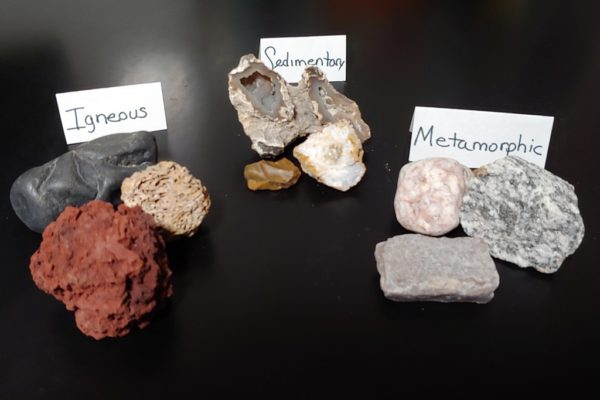
Characteristics of Rocks
There are a few factors that affect all rocks. To start with rocks can form underground (intrusive) or above ground (extrusive). They can cool quickly or r-e-a-l-l-y slooooow. These factors, along with chemical and mineral contents, will determine the type of rock, as well as the color and content.
Think about making cookies. You can choose to make no-bake or baked cookies. The core ingredients are typically the same like flour, sugar, and butter but then there is a wide range of additives like, chocolate chips, raisins, nuts and whatever else the recipe requires. You can make a wide variety of cookies, in fact, the possibilities are endless!
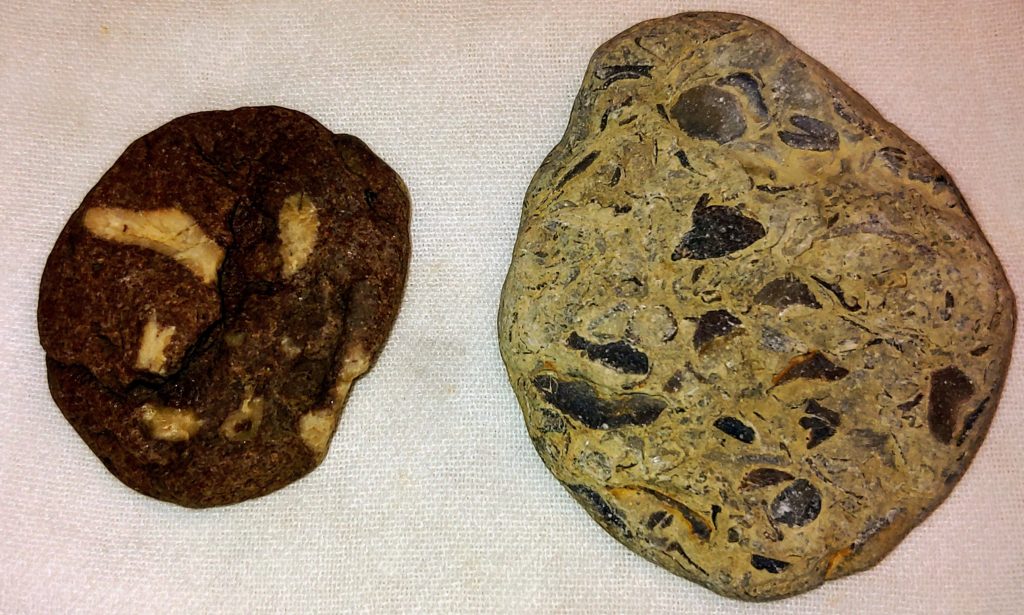
Rocks are similar – except minerals become the additives. Just like cookies, rocks have core ingredients such as lava, magma, mud, silt, clay, or clasts. Mixing in minerals and different chemicals will decide the coloration, while the location (internal vs external) and cooling conditions will affect the grains and overall look of the rock. The possibilities are endless!
Rock Type 1: Igneous Rocks
When molten magma cools it forms an Igneous rock. This fire-formed rock is the most common on earth and found on all continents. While Australia had volcanoes several thousand years ago, it is currently the only continent that does not have an active volcano. Most people think of igneous rocks as having cooled as it oozes down the side of a volcano. Contrary to popular belief, most igneous rocks cool and harden beneath the earth’s surface.
Molten, liquid rock called ‘magma‘, churns beneath’s the earth’s surface. When a fissure (or crack) forms in the earth’s crust, it opens a space for magma to escape and a volcano forms. Once magma spills out on the earth’s crust it becomes lava.
The change from magma to lave comes from the Italian meanings of both words. Magma means a ‘thick, pasty substance’ which perfectly describes molten rock underground. Lava means ‘to slide’ which is what lava does when it flows down the volcano.
Check this out!
Color adds to a rock’s story.
There are over 700 types of igneous rocks! Below is a photo of lava rocks that I collected in Iceland. One country, so many colors. Each of these rocks came from different locations and every one of them have a story! They cooled at varying rates and have a different mix of chemicals and minerals making each unique.
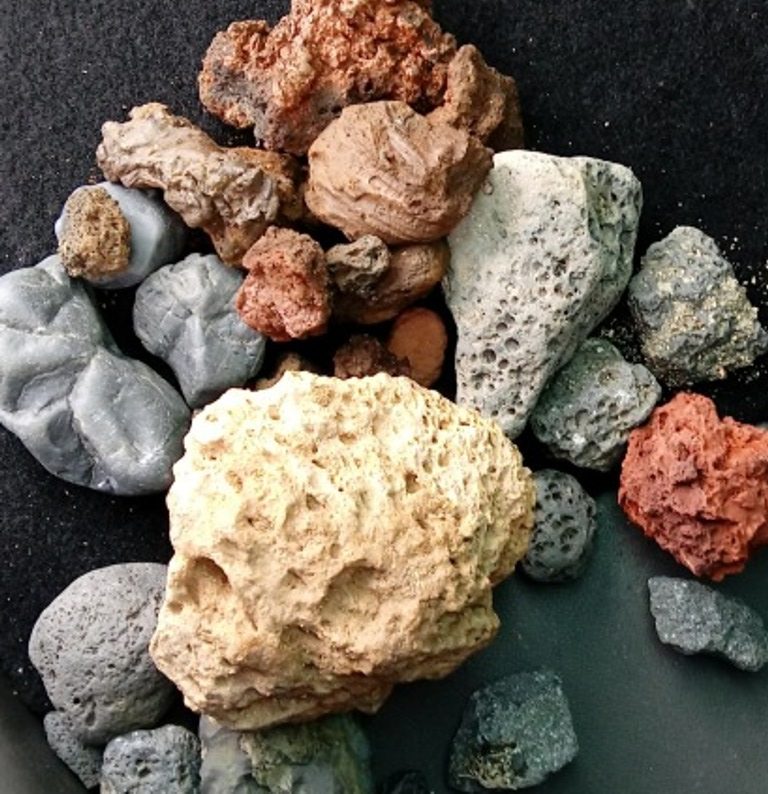
Obsidian: an Extrusive Igneous Rock
Volcanic glass, also known as Obsidian, cools so quickly that crystals never have a chance to form. It is an extrusive rock that is black with a glassy look and a smooth texture. During the stone age, tool makers discovered that obsidian fractured easily so they created tools and weapons from a process called knapping. An arrowhead is definitely a rock with a story! I shudder to think what type of story it might have known!

Knapping
Knapping is the process of working a stone into a usable tool or weapon. If you have not seen flint knapping before, here is a video showing the process.
Granite: An Intrusive, Igneous Rock
When magma becomes wedged into a cavity deep inside the earth, it cools slowly and eventually turns into a rock called Granite. Intrusive rocks, form under the earth’s surface. (Extrusive rocks form on top of the crust.) See the ‘in‘ at the beginning of intrusive? That should remind you of the word ‘inside’, as in ‘inside’ the earth.
Granite is common on all continents and has large mineral crystals. When the earth’s plates move and collide, the granite slides towards the earth’s surface, sometimes exposing it as an outcrop. Glaciers also helped move granite around by picking it up and depositing it in other locations. Now that is a travel story!
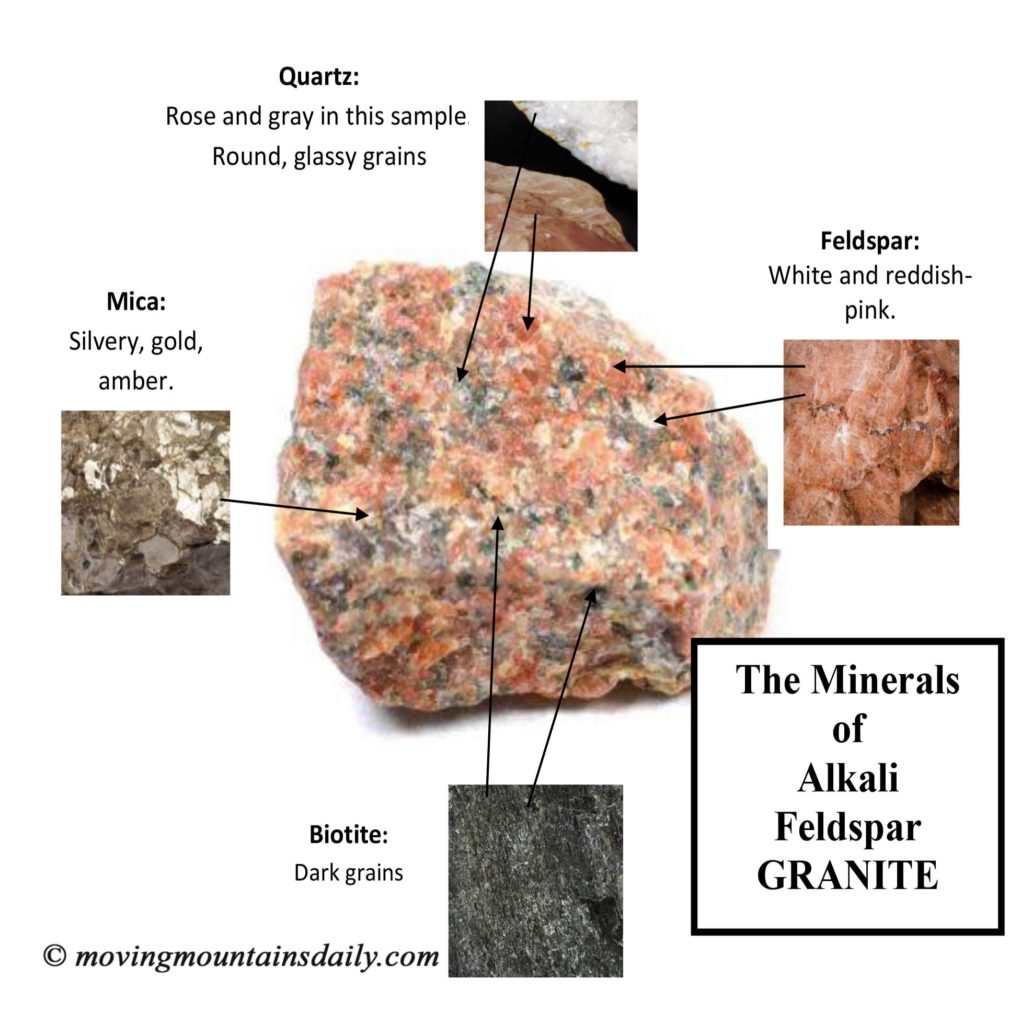
Basalt
Most of the earth’s crust contains a dark, grainy rock called basalt. Columnar Joints known as basalt columns occur when the magma cooled and then contracted. Contraction happens because hot things take up more room than cool things. When the magma contracted, or shrunk, it caused stress fractures that ran down the side of the joint and created awesome looking hexagonal shapes.
My kids and I had a great time climbing and navigating the different sized columns that we found in Iceland. It was a ‘real’ rock climbing wall!

Contraction can also explain why we get potholes in our roads. The asphalt contracts when it cools and expands when the hot sun warms the surface. Cracks occur, cars worsen the condition, and before you know it, you have potholes that the local deer think are community water holes.
I have a hole-y rock!
When molten rock cools quickly, the gas bubbles have no time to escape. As the rock hardens, the gas leaves deep pits called, vesicles. Here are three different types of Igneous rocks. The back two are covered with vesicles, while the front specimen is dense basalt that twisted and hardened slowly.

The Year There was no Summer
You have to admit, a year with no summer is a horrifying thought.
Rock Type 2: Sedimentary Rocks
The name sedimentary should make this rock type easy to remember. A sedimentary rock contains small pieces of eroded matter like pebbles, sand, shells, bones, remains of living creatures, and organic debris (plants). The sediments, also known as clasts, can vary in size. Natural forces like wind, water, and ice (glaciers!) transport and deposit the sediments. As the layers multiply, the weight compacts and squeezes the bottom sediments together. If you have finished the post, “Anatomy of a Glacier” this should sound familiar!
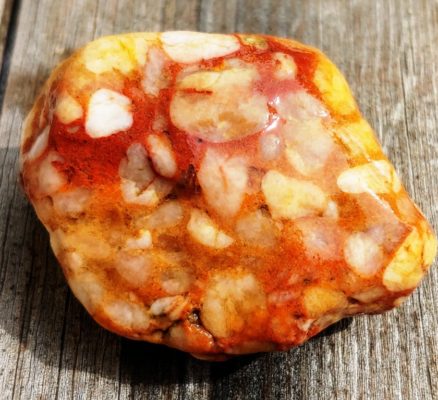
This is my favorite rock!
The secret to the creation of a sedimentary rock lies in the water that carries dissolved minerals. When the bottom layer of squished sediments start to dry out, the water evaporates leaving behind soggy minerals. The drying layers begin to harden and as the minerals grow into crystals, they cement or glue all the layers of sediments together.
Different Types of Sedimentary Rocks
There are many types of sedimentary rocks, I’ll touch on a few that you will most likely come across while playing and wading in the local creeks and rivers.

I found the above effigy rock on a sandbar in a local river. An effigy is a representation of a person or an animal. It is really cool looking but it is also disturbing at the same time. It is the only rock I possess that gives me mixed feelings: sometimes I like it, but most of the time I don’t. Every rock has a story and I have a feeling this one has a lot of secrets!
Sandstone
Sandstone is a sedimentary rock. Guess what material makes up the layers of sandstone? All rocks should be so easy to determine! Compacted layers of sand deposits build up in desert dunes, lakes, rivers, and on the ocean floor. Quartz, feldspar, or iron oxide crystals cement the minerals which will and determine the color of the stone. If the primary mineral is quartz, the color will be tan. Feldspar will create an amber color, while iron oxide creates a red-orange coloration. A sandstone will sparkle in the sunlight and will feel rough like sand.

The more you handle a sandstone, you will begin to see sediments on the surface in front of you because the stone is soft and easily eroded. Sandstone with wavy layers of color means that the deposits came from sand dunes. However, if the layers look striped, then the layering process came from a water source. Where do you think this sandstone above was formed? What minerals make up this stone?
Fossiliferous Limestone
Fossiliferous is a cool word! Did you notice the root word ‘fossil‘? Only sedimentary rocks can contain fossils. A fossiliferous limestone formed underwater from bits and pieces of dead plants, corrals, shells, and skeletons. Fossils help piece together the story of the earth’s history. You will discover that limestone layers and fossils vary by location.
Here are three different types of fossiliferous limestone. The one on the left came from Kentucky, the fossil on the right came from Indiana, but my favorite (top), I picked up on the shores of Lake Huron. All three locations have varying types of fossil remains. I like the Lake Huron fossil because it shows all the different layers of compacted sediment. It looks like a big piece of layered cake!
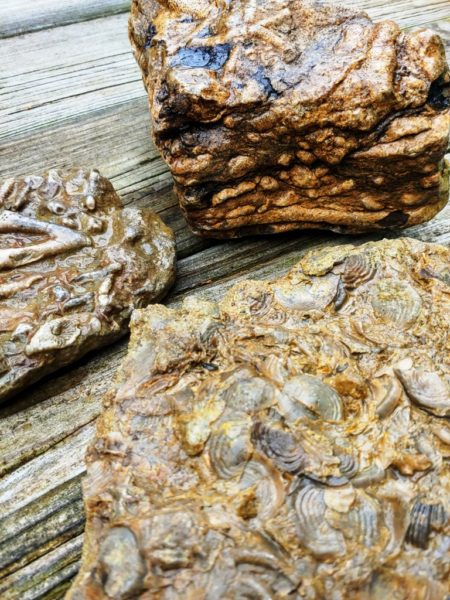
Every Rock has a Story – Especially Artifacts.
The sedimentary stone below tells a story of ancient living marine life, as well as a story about the native people who once lived in Southeast Indiana. Notice the shape of this rock? A long time ago, a stone cutter altered the natural shape, polished it smooth, and tethered it to a handle. The tethering and usage gouges the sides, adding character and historic proof to the story of this artifact.

Conglomerates
A conglomerate is a sedimentary rock that consist of large pieces of sediment. One of my favorites is the Puddingstone. It has an incredible story and one that is definitely worth telling.
The following picture features two types of Puddingstones, one found on the shores of Lake Huron, and the other in a Southeast Indiana riverbed.
Notice the difference in the appearance. Using scientific deduction, your job will be to determine the location where each rock was found in the Puddingstone Mystery Lab.
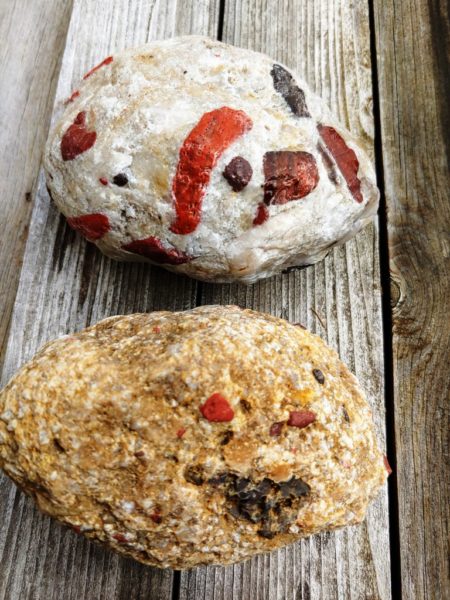
Once you have finished your investigation and solved the mystery, then you can check see if you were right!
Rock Type 3: Metamorphic Rocks
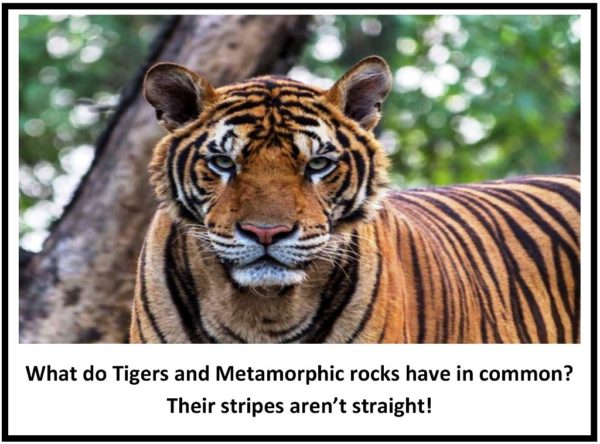
Metamorphic rocks were once sedimentary, igneous rocks, and other metamorphic rocks. The metamorphosis (change) happens deep below the earth’s crust where high temperatures and pressure changes their structure. The original rocks do not fully melt, or they would all end up as an igneous rocks. Instead, it is the crystal structure that undergoes a makeover. The mineral grains will flatten, line up, and will sometimes separate into layers of different densities.
Foliated vs Non-Foliated
The patterns of metamorphic rocks depends on where they form within the earth. There is less heat closest to the crust, so the crystal patterns become randomly spaced, or non-foliated. But the rocks that form deeper in the earth where the heat and pressure is much more intense, have foliated patterns. The mineral grains will flatten, line up, and will sometimes separate into layers of different densities, causing uneven stripes – like a tiger!
Foliated = Striped
Non-foliated = No Stripes
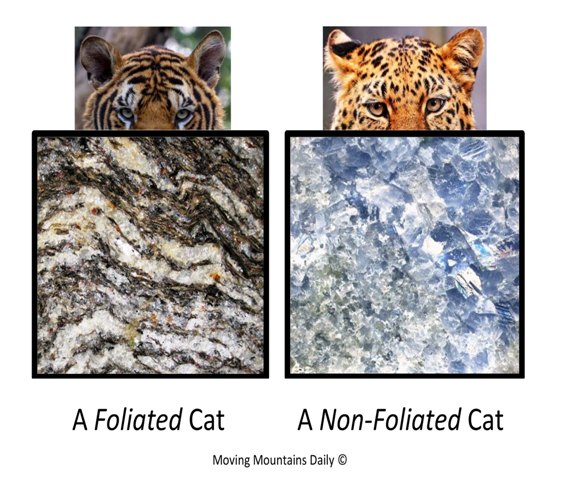
When looking at a metamorphic rock it is not always possible to determine the original parent rock. Sometimes many parent rocks at the same time will get a makeover and turn into one metamorphic rock.
If we were to travel from the earth’s crust to the center of the earth, we would find that the heat and pressure would intensify as we got closer to the center. The varying degrees creates different types of metamorphic rocks. Crystal size and coarseness of foliation increases with depth. This image will help explain.
Regional Metamorphism
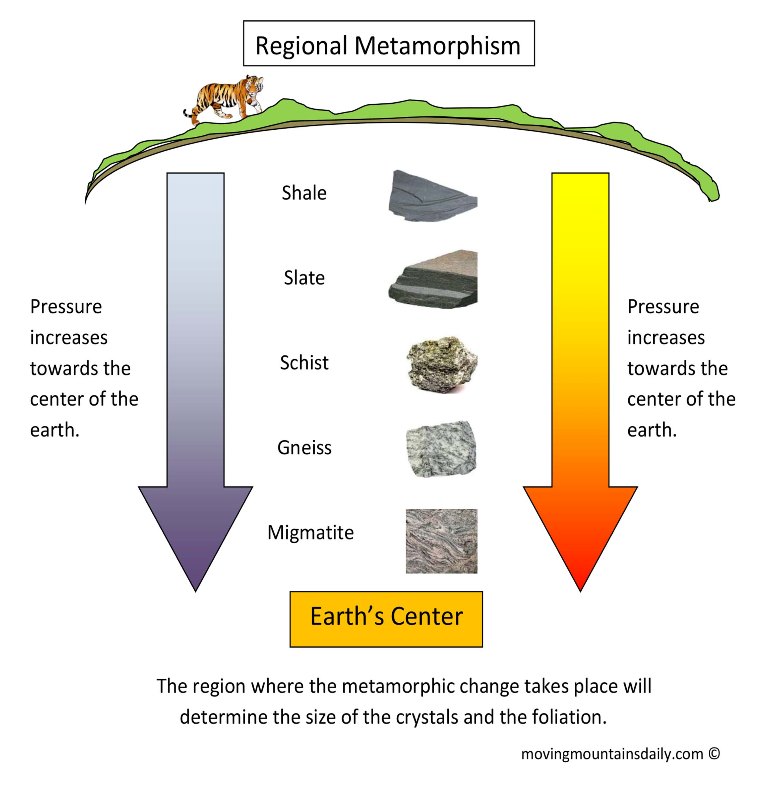
Becoming a Rock Hound
There is no doubt about it. Rocks are just plain cool. A rock hound is a person who has a passion for collection rocks. It is really easy to start. Just pick up a rock!
You might think your gravel driveway is just plain boring rocks. Take a plastic bowl of water out and chose some specimens to dip. The water will highlight the different characteristics and crystals of the rocks. You will discover that there are different types and colors that you didn’t know was so close to home. You can start a collection based on color, size, type, or based on the fact, that you just like it!
My Rock Hunting Secret
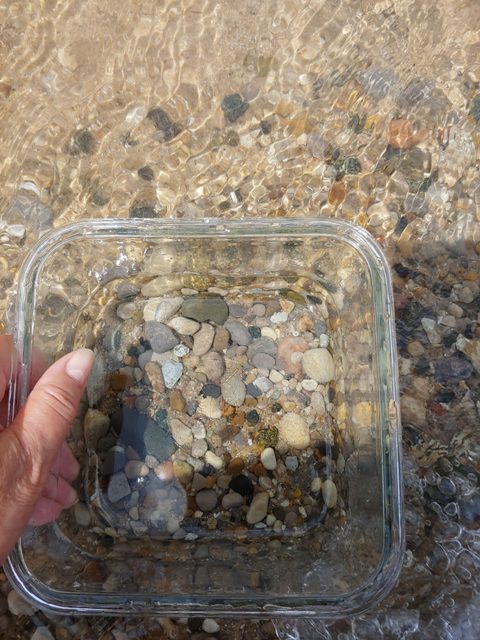
One of the methods I use when hunting along the shores of a lake or river is to float a clear container on the surface of the water. The container breaks the surface tension, stills the movement, and allows you to see the bottom clearly. When I see something special I can pluck it and pop it into the container!
Happy rock hunting and remember:
Leave no Stone Unturned!
Check out our other Geoscience Labs. Next in the series is: Minerals are Everywhere
Tell us about your rock collections in the comment section! Do you have a favorite rock? What is the weirdest rock you have ever found?


